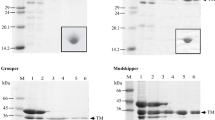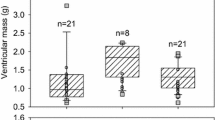Summary
Sarcoplasmic reticulum has been isolated from the white muscle of 15 species of teleost fish adapted to diverse thermal environments. Evidence has been obtained that the Ca2+-dependent ATPase of fish sarcoplasmic reticulum has undergone evolutionary modification for function at different temperatures. Compared with tropical fish, cold adapted species have higher rates of Ca2+ transport and Ca2+-ATPase activities at low temperatures. Most species have linear Arrhenius plots over the temperature range 0–30°C. Activation enthalpies (ΔH ≠) of the ATPase ranged from 53–190 kJ mol−1 and were positively correlated with environment temperature. Activation entropy (ΔS ≠) varied from negative values in cold adapted species to positive values in tropical fish.
In contrast to the Ca2+-ATPase, the “basal” ATPase of fish sarcoplasmic reticulum showed no relationship between either ATPase activity or thermodynamic activation parameters and environmental temperature.
Only the Ca2+-dependent ATPase is coupled to Ca2+ transport. The percentage of “total” ATPase activity which is Ca2+ activated is higher at low temperatures in cold than in warm adapted species. For example, ratios of Ca2+-dependent/total ATPase at 2°C varied from 80–98% in Arctic, Antarctic and North Sea species to only 2–50% in various tropical fish. Above 20°C, similar ratios in the range 80–98% were obtained for all species. The nature of the “basal” ATPase and mechanisms of temperature adaptation of fish sarcoplasmic reticulum are discussed.
Similar content being viewed by others
Abbreviations
- ET :
-
environmental temperature
- EGTA :
-
ethylene glycol-bis (β-aminolethyl ether)-N, N′-tetraacetic acid
- HEPES :
-
N-2-hydroxylpiperazine-N′-2-ethanesulfonic acid
- SR :
-
sarcoplasmic reticulum
References
Chapman, D.: Phase transitions and fluidity characteristics of lipids and cell membranes. Q. Rev. Biophys.8, 185–235 (1975)
Cossins, A.R.: Adaptations of biological membranes to temperature. The effect of temperature acclimation of goldfish upon the viscosity of synaptosomal membranes. Biochim. Biophys. Acta.470, 395–411 (1977)
Cossins, A.R., Prosser, C.L.: Evolutionary adaptation of membranes to temperature. Proc. Natl. Acad. Sci. USA75, 2040–2043 (1978)
Cossins, A.R., Friedlander, M.J., Prosser, C.L.: Correlations between behavioural temperature adaptation of goldfish and the viscosity and fatty acid composition of the synaptic membranes. J. Comp. Physiol.120, 109–121 (1977)
Cossins, A.R., Christiansen, J., Prosser, C.L.: Adaptations of biological membranes to temperature. The lack of homeoviscous adaptation in the sarcoplasmic reticulum. Biochim. Biophys. Acta.511, 442–454 (1978)
Davis, D.G., Inesi, G., Gulik-Krzywicki, T.: Lipid molecular motion and enzyme activity in sarcoplasmic reticulum membranes. Biochem.15, 1271–1276 (1976)
Eletr, S., Inesi, G.: Phase changes in the lipid moieties of sarcoplasmic reticulum membrane induced by temperature and protein conformational change. Biochim. Biophys. Acta290, 178–185 (1973)
Hazel, J.R.: The regulation of cellular function by temperature induced alterations in membrane composition. In: Effects of temperature on ectothermic organisms. Wieser, W., (ed.), pp. 55–67. Berlin, Heidelberg, New York: Springer 1973
Hazel, J.R., Prosser, C.L.: Molecular mechanisms of temperature compensation in poikilotherms. Physiol. Rev.54, 620–677 (1974)
Headon, D.R., Barrett, E.J., Joyce, N.M., O'Flaherty, J.: Cholesterol in muscle membranes. Mol. Cell. Biochem.17, 117–123 (1977)
Heilmann, C., Brdiczka, D., Nickel, E., Pette, D.: ATPase activities, Ca2+ transport and phosphoprotein formation in sarcoplasmic reticulum subfractions of fast and slow rabbit muscles. Eur. J. Biochem.81, 211–222 (1977)
Hidalgo, C., Ikemoto, N., Gergely, J.: Role of phospholipids in calcium-dependent ATPase of the sarcoplasmic reticulum. Enzymatic and ESR studies with phospholipid replaced membranes. J. Biol. Chem.251, 4224–4232 (1976)
Hochachka, P.W., Somero, G.M.: Strategies of biochemical adaptation. Philadelphia: Saunders 1973
Inesi, G., Maring, E., Murphy, A.J., McFarland, B.H.: A study of the phosphorylated intermediate of sarcoplasmic reticulum ATPase. Arch. Biochem. Biophys.138, 285–294 (1970)
Inesi, G., Cohen, J.A., Coan, C.R.: Two functional states of sarcoplasmic reticulum ATPase. Biochem.15, 5293–5298 (1976)
Johnson, P.V., Roots, B.I.: Brain lipid fatty acids and temperature acclimation. Comp. Biochem. Physiol.11, 303–309 (1964)
Johnston, I.A., Walesby, N.J.: Molecular mechanisms of temperature adaptation in fish myofibrillar adenosine triphosphatases. J. Comp. Physiol.119, 195–206 (1977)
Johnston, I.A., Walesby, N.J.: Evolutionary temperature adaptation and the calcium regulation of fish actomysin ATPases. J. Comp. Physiol.129, 169–177 (1979)
Johnston, I.A., Frearson, N., Goldspink, G.: The effects of environmental temperature on the properties of the myofibrillar adenosine triphosphatase from various species of fish. Biochem. J.133, 735–738 (1973)
Johnston, I.A., Walesby, N.J., Davison, W., Goldspink, G.: Further studies on the adaptation of fish myofibrillar ATPases to different cell temperatures. Pflügers Archiv371, 257–262 (1977)
Knipprath, W.G., Mead, J.F.: Effect of environmental temperature on fatty acid composition and on thein vivo incorporation of 1-14C acetate in goldfish (Carassius auratus). Lipids3, 121–128 (1968)
Knowles, A.R., Eytan, E., Racker, E.: Phospholipid-protein interactions in the Ca2+ adenosine triphosphatase of sarcoplasmic reticulum. J. Biol. Chem.251, 5161–5165 (1976)
Low, P.S., Somero, G.N.: Adaptation of muscle pyruvate kinases to environmental temperatures and pressures. J. Exp. Zool.198, 1–11 (1976)
Low, P.S., Bada, J.L., Somero, G.N.: Temperature adaptation of enzymes: role of the free energy, the enthalpy and the entropy of activation. Proc. Natl. Acad. Sci. USA70, 430–432 (1973)
Lowry, O.H., Rosebrough, N.J., Farr, A.L., Randall, R.S.: Protein measurement with the Folin phenol reagent. J. Biol. Chem.193, 265–275 (1951)
Maddy, A.H., Spooner, R.O.: The erythrocyte agglutinability I. Variation in the membrane protein. Vox. Sang.18, 34–41 (1970)
Madeira, V.M.C., Antunes-Madeira, M.C.: Lipid composition of biomembranes: a complete analysis of sarcoplasmic reticulum phospholipids. Cienc. Biol. Portugal2, 265–291 (1976)
McArdle, H.J., Johnston, I.A.: Evolutionary temperature adaptation of the calcium dependent adenosine triphosphatase of fish sarcoplasmic reticulum. Biochem. Soc. Trans.7, 69–72 (1979a)
McArdle, H.J., Johnston, I.A.: Temperature adaptation and calcium transport by fish skeletal muscle microscomes. Biochem. Soc. Trans.7, 517–519 (1979b)
Meissner, G., Fleischer, S.: Dissociation and reconstitution of functional sarcoplasmic reticulum vesicles. J. Biol. Chem.249, 302–309 (1974)
Morse, P.D., Ruhlig, M., Snipes, W., Keith, A.D.: A spin-label study of the viscosity profile of sarcoplasmic reticulum vesicles. Arch. Biochem. Biophys.168, 40–56 (1975)
Rockstein, M., Herron, P.W.: Colorimetric determination of inorganic phosphate in microgram quantities. Anal. Chem.23, 1500–1501 (1951)
Shigekawa, M., Akowitz, A.A.: On the mechanism of Ca2+-dependent adenosine triphosphatase of sarcoplasmic reticulum. J. Biol. Chem.254, 4726–4730 (1979)
Shigekawa, M., Dougherty, J.P.: Reaction mechanism of Ca2+-dependent ATP hydrolysis by skeletal muscle sarcoplasmic reticulum in the absence of added alkali metal salts. II. Kinetic properties of the phosphoenzyme formed at the steady state in high Mg2+ and low Ca2+ concentrations. J. Biol. Chem.253, 1451–1457 (1978)
Sinesky, M.: Homeoviscous adaptation — a homeostatic process that regulates the viscosity of membrane lipids in Escherichia coli. Proc. Natl. Acad. Sci. USA71, 522–525 (1974)
Somero, G.N., Low, P.S.: Temperature: A “shaping force” in protein evolution. Biochem. Soc. Symp.46, 33–42 (1976)
Tume, R.K., Hunington, M.: Calcium uptake by sarcoplasmic reticulum. A note on the effect of oxalate and phosphate on the measurement of45Ca2+. Anal. Biochem.61, 614–617 (1974)
Warren, G.B., Toon, P.A., Birdsall, N.J.M., Lee, A.G., Metcalfe, J.C.: Reconstitution of calcium pump using defined membrane components. Proc. Natl. Acad. Sci. USA71, 622–626 (1974)
Author information
Authors and Affiliations
Rights and permissions
About this article
Cite this article
McArdle, H.J., Johnston, I.A. Evolutionary temperature adaptation of fish sarcoplasmic reticulum. J Comp Physiol B 135, 157–164 (1980). https://doi.org/10.1007/BF00691205
Accepted:
Issue Date:
DOI: https://doi.org/10.1007/BF00691205




